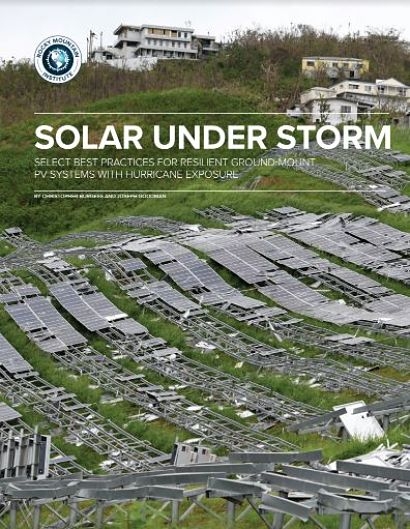
Over half the utilities in the Caribbean now own or operate solar PV as part of their generation mix. Over 225 MW of solar is installed on rooftops, parking canopies and large areas of land. Solar PV is also the most rapidly growing source of power for many Caribbean Islands.
The 2017 hurricane season was one of the most active in history, with Hurricanes Harvey, Irma and Maria bring widespread destruction to the region. In addition to the emotional toll, the disruption of critical infrastructure left many communities without electricity, and other basic services, for prolonged periods of time. However, despite record sustained wind speeds of over 180 miles per hour, many solar PV systems in the Caribbean survived. Some solar installations in the British Virgin Islands, Turks and Caicos, Puerto Rico, and St. Eustatius faced tremendous wind yet continued producing power the following day. In contrast, some PV systems in Puerto Rico, the US Virgin Islands, and Barbuda suffered major damage or complete failure with airborne solar modules, broken equipment, and twisted metal racking.
The Rocky Mountain Institute (RMI) has now released a report delivering actionable recommendations for increasing resiliency among retrofit and new construction solar PV installations, based on a combination of recent field observations with expert analysis.
The report is split into four sections, of which two are aimed at engineering professionals responsible for PV system design, specifications and/or system construction oversight and approval. The other two sections are aimed at a more general audience of governments, utilities, regulators, developers, and PV system installers who are interested in improving PV system survivability to intense wind-loading events. The recommendations are split into two categories to do with specifications and collaboration.
The RMI field analysis teams noted similarities between the failed systems, including module clamp failures, undersized racks, undersized and under-torqued bolts, a lack of bolt locking solutions, and a lack of lateral racking support. On the flip side, the systems that survived had the modules through bolted (no clamps), bolts with locking solutions, and lateral racking supports.
However, developing hurricane resiliency guidelines based only on observed failure modes has limitations. The observed failure modes may have served as a “mechanical fuse,” relieving forces from the system. If future systems address only those observed failures, forces may precipitate additional failure modes. To address both observed and potential failure modes, RMI used a common reliability tool for systematic cause and effect identification called a fishbone diagram. This shows critical elements from the supply chain through design, construction, and operations of solar PV projects.
Calculating the additional cost to implement the recommendations in the Solar Under Storm report depends on the specific projects and sites. However, RMI estimates that a 1 MW ground mount project on suitable soil and flat terrain in the Eastern Caribbean would incur an increase of approximately 5 percent in engineering, procurement, and construction (EPC) costs when these best practices are implemented versus the standard category IV rated installation. These additional costs come in the form of labour for the extra time needed to through-bolt the modules and install more foundation and racking supports. There are also additional costs in material (racking supports, dual post piers, and fasteners) as well as minor costs for additional engineering and construction oversight.
Based on RMI’s Islands Energy Programme’s most recent solar PV procurement for a 1 MW ground mount system in the Caribbean, implementing the best resiliency practices would add approximately $90,000 in EPC costs to the budget. This overall project price increase is about the difference in module pricing from 2017 to 2018, and for Caribbean projects that procure modules later in 2018, the price drop could completely net out the additional resilient mitigation costs by year’s end.
As the intensity and number of hurricanes rise, utilities, regulators, engineering professionals, and PV system developers and installers must be aware of the best available engineering, design, delivery, and operational practices to ensure these installations survive.
While the Solar Under Storm report cannot predict all the potential failures and consequent mitigation strategies, it provides an available set of best practices regarding specifications of equipment and procedures along with a framework for continued collaboration within a community of practice. The RMI hopes that by sharing best practices and through continued collaboration with designers, suppliers, and manufacturers, the reliability and survival rates of PV systems in hurricanes can be increased, thereby ensuring that the people of the Caribbean have resilient and reliable power for their grids, homes, businesses, and critical facilities for decades to come.
For additional information:

